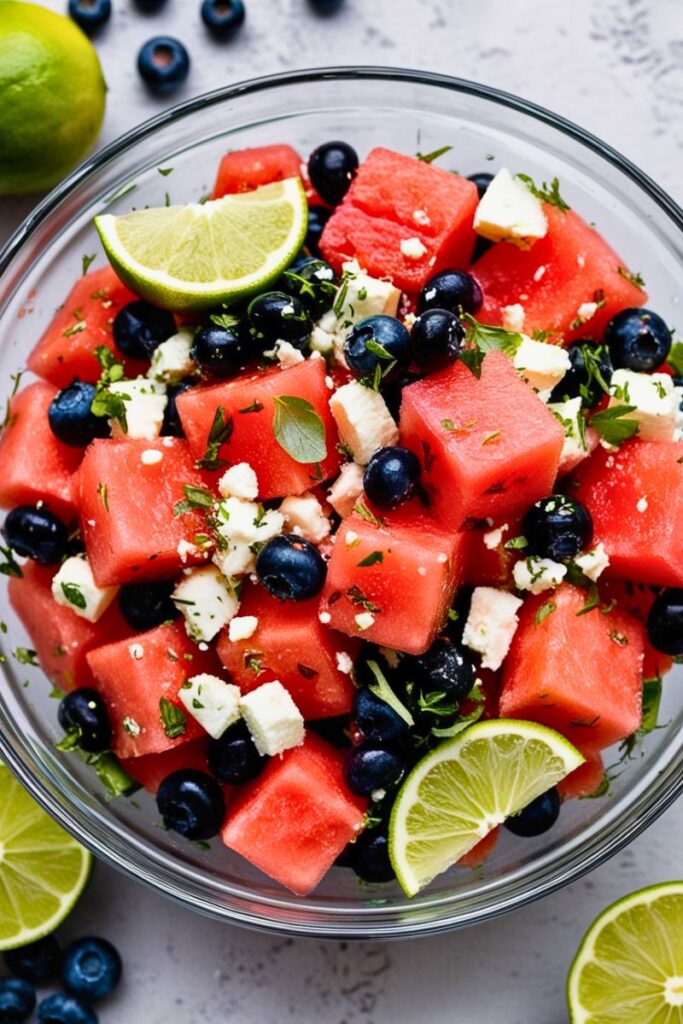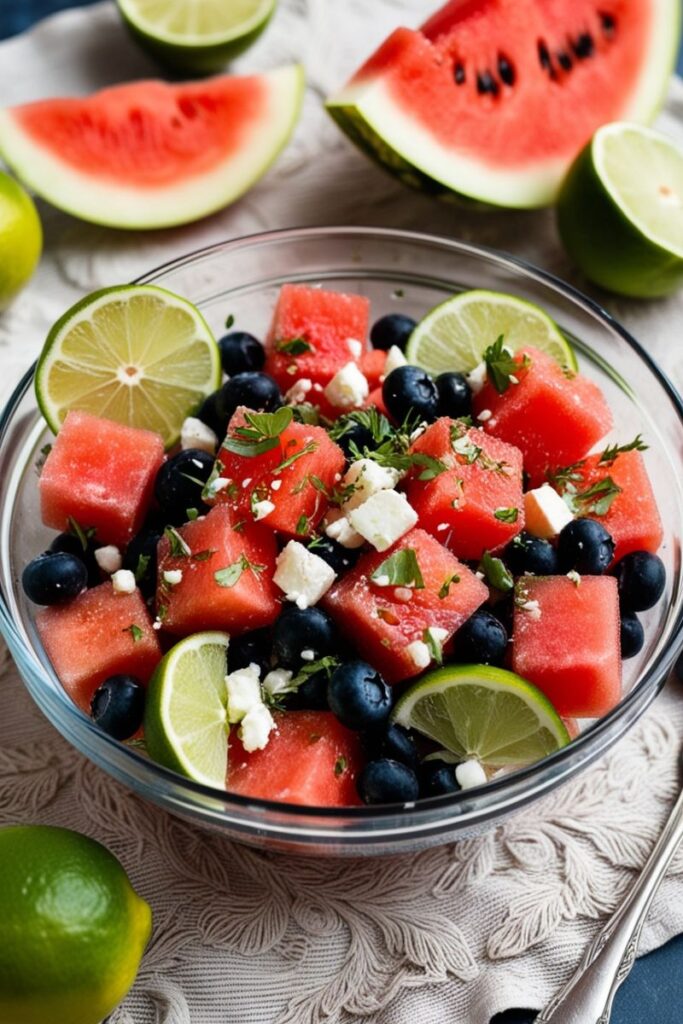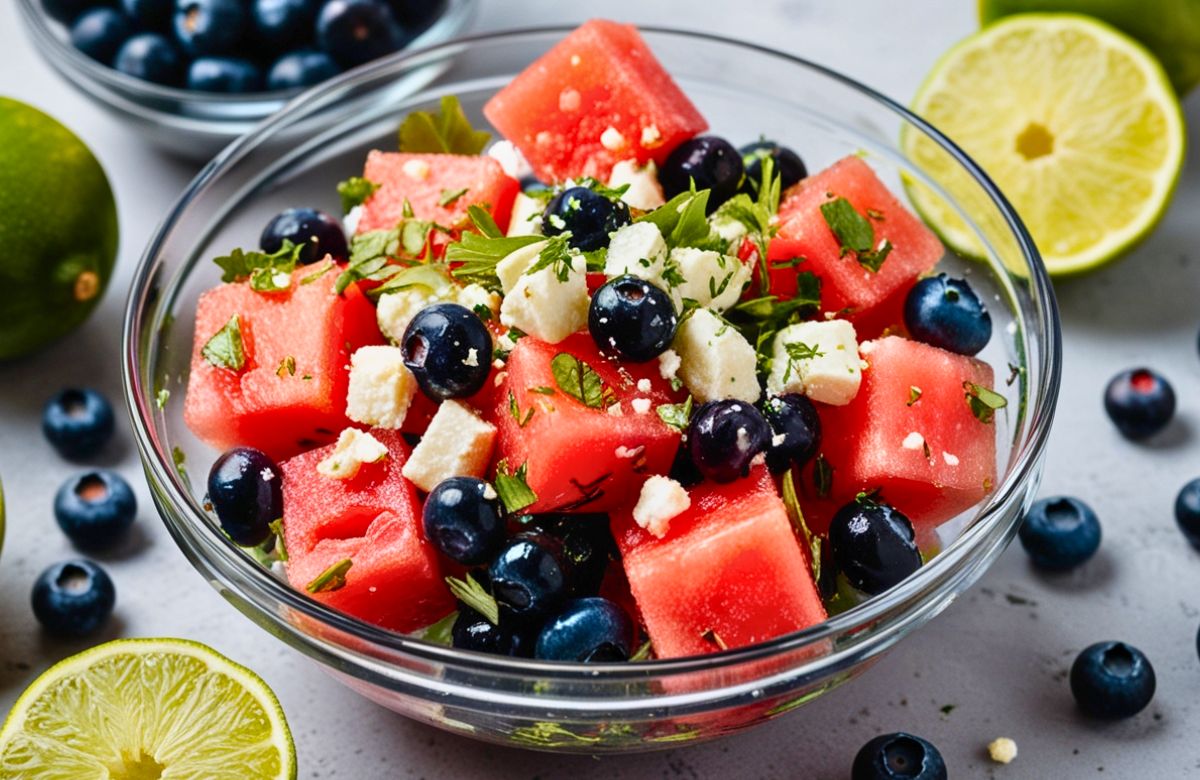Is there anything more refreshing than biting into a juicy watermelon on a hot summer day? Now imagine elevating that experience with a salad that’s bursting with sweet, salty, tangy, and fresh flavors all in one bowl.
Watermelon salad isn’t just a side dish; it’s a celebration of summer. With simple ingredients like crisp cucumbers, creamy feta, fresh mint, and a zingy lime dressing, this salad brings together surprising combinations that work in perfect harmony.
In this post, you’ll discover how to make the ultimate watermelon salad that’s not only easy and quick but also a total crowd pleaser. Whether you’re preparing for a picnic, BBQ, or just a light lunch, this recipe will bring a burst of flavor and color to your table.
Ingredients & Substitutions
The Foundation: Watermelon
Selecting the right watermelon forms the cornerstone of an exceptional watermelon salad. Look for melons that feel heavy for their size, with a deep, hollow sound when tapped. The underside should show a creamy yellow patch (called the “field spot”) where it rested on the ground—the more pronounced and yellow this spot, the longer the melon ripened on the vine.
Personal seedless watermelons offer convenience, but traditional seeded varieties often deliver superior flavor complexity. In a professional kitchen, we’d typically use the heart of the melon (the sweetest part), saving the paler flesh near the rind for other applications like pickling or aqua fresca. For a vibrant and flavorful watermelon salad, home cooks can confidently use most of the melon minus the outer 2cm, where bitterness can sometimes lurk.
Can’t find good watermelon? While not identical, cantaloupe or honeydew can substitute in emergency situations. Each brings a different flavor profile but maintains the crucial juicy, refreshing quality. Some innovative chefs have even experimented with compressed cucumber as an alternative base for a uniquely textured twist on a classic watermelon salad..
The Counterpoints: Cheese, Herbs & Alliums
Feta cheese provides the traditional salty counterbalance to watermelon’s sweetness, but don’t limit yourself. French sheep’s milk feta offers tangy complexity, while Bulgarian varieties bring more robustness. Queso fresco works beautifuly for a milder approach, and plant based alternatives like almond based feta provide excellent options for vegan diners.
Fresh herbs breathe life into watermelon salad. Mint remains the classic pairing, but basil (particularly Thai basil) contributes peppery notes, while cilantro adds citrusy brightness. For something unexpected, try fresh oregano or tarragon both create intriguing flavor bridges to other ingredients.
Allium elements provide crucial aromatic depth. Thinly shaved red onion offers traditional sharpness, while spring onions lend a gentler touch. For maximum sophistication, try quick pickled shallots. Their vinegary bite cuts through the watermelon’s sweetness while adding complexity.
Acid, Salt & Fat: The Flavor Enhancers
Acid brightens everything. Fresh lime juice remains my preference, but champagne vinegar, white balsamic, or even yuzu juice can create fascinating variations. The key lies in restraint; acidity should enhance the watermelon’s natural sweetness, not overwhelm it.
Salt doesn’t just season it fundamentally transforms watermelon, drawing out moisture and intensifying sweetness. Beyond standard kosher salt, consider fleur de sel for finishing, smoked salt for complexity, or even a light dusting of tajín (Mexican chili lime salt) for heat and tang.
Fat rounds everything out. High quality extra virgin olive oil is traditional, but experimenting with specialty oils yields remarkable results. Pistachio oil creates nutty elegance, while avocado oil provides buttery richness without overwhelming the delicate watermelon flavor.
Building Complexity: Additional Elements
For textural contrast, consider adding cucumber (Persian or English varieties work best), fennel shaved paper thin, or even jicama. Each adds refreshing crunch while complementing watermelon’s juiciness.
Nuts and seeds introduce another textural dimension toasted pistachios, pine nuts, or pepitas all work wonderfully. For maximum flavor, toast them yourself just before serving rather than using pre toasted varieties.
Heat elements create compelling counterpoints to watermelon’s coolness. Fresh chilis (serrano, jalapeño, or Thai bird’s eye) sliced paper thin add pleasant heat, while Aleppo pepper or Urfa biber contribute more complex, smoky warmth.
Step by Step Instructions

Preparation: Setting Up for Success
Begin by chilling your watermelon thoroughly at least 4 hours in the refrigerator. Cold watermelon not only tastes better but also holds its shape during cutting and plating. A common mistake is working with room temperature melon, which can quickly become mushy and leak excessive juice.
Prepare your workspace with several clean kitchen towels to manage watermelon’s abundant moisture. Professional chefs often work atop towel lined cutting boards to absorb excess liquid and prevent ingredients from becoming waterlogged.
Sharpen your knife before starting! A dull blade crushes watermelon cells rather than cleanly cutting them, resulting in mushy texture and diluted flavor. I prefer a longer blade (8 10 inches) for smooth, continuous cuts through large melon sections.
Cutting Techniques: Precision Matters
Remove both ends of the watermelon to create stable flat surfaces, then stand it on one end and carefully cut away the rind in downward strips, following the melon’s natural curve. Work to leave minimal pink flesh attached to discarded rind that’s profit margin walking into the bin!
For classic presentation, cut the peeled watermelon into precise 1 inch cubes. For more contemporary styling, try 1/4 inch thick triangles or use a melon baller for spheres. Want something really impressive? Cut paper thin watermelon sheets using a mandoline (carefully!), then roll them around herb infused cheese for elegant appetizers.
Allow cut watermelon to drain briefly on paper towels before assembling. This prevents excess juice from diluting your dressing and sogging other ingredients. Don’t skip this step it’s the difference between professional results and amateur execution.
Assembly: Building Flavor Layers
Start by macerating red onions or shallots in your acid component (lime juice, vinegar, etc.) for 5-10 minutes. This softens their sharpness while infusing the acid with allium flavor a chef’s trick for building depth without aggressive raw onion notes.
Combine your main components (watermelon, cheese, herbs) in a bowl larger than you think you need. Limited space leads to bruised watermelon and broken cheese crumbles. Gently fold ingredients rather than stirring vigorously, we’re not making smoothies here!
Season incrementally, tasting as you go. Watermelon vary drastically in sweetness, so proper balancing requires adjustment with each batch. Add salt gradually it’s astonishing how quickly watermelon transforms from bland to perfectly seasoned to over salted.
Finishing Touches: The Professional Difference
Dress the salad just moments before serving. The difference between a salad dressed 5 minutes ago versus 20 minutes ago is profound especially with delicate ingredients like watermelon and fresh herbs.
Reserve a small portion of herbs, cheese, and any garnishes for the final presentation. This ensures visual appeal with every bite and signals professional attention to detail. In restaurant kitchens, we call this “rebuilding” the dish, ensuring the last bite looks as good as the first.
For temperature contrast, consider briefly chilling your serving plates. The cold surface helps maintain the watermelon’s refreshing quality from first bite to last, particularly important for outdoor summer service.
Watermelon Salad: Techniques & Science Behind the Perfect Bite
The Chemistry of Watermelon
Watermelon’s transformation in salad form relies on fascinating food chemistry. The fruit contains significant glutamic acid, the compound responsible for umami flavor, which becomes more pronounced when combined with salt and acid. This explains why properly seasoned watermelon suddenly tastes “meatier” and more complex.
The osmotic pressure caused by salting draws out some of watermelon’s abundant water content (it’s 92% water, afterall), concentrating both flavor and sweetness. This same process slightly firms the texture, preventing the melon from becoming mushy as quickly when mixed with other ingredients.
When preparing watermelon in advance, understand that its cell walls are relatively fragile. Cutting activates enzymes that begin breaking down pectin the “glue” holding fruit cells together. This is why cut watermelon becomes increasingly soft over time, and why professional kitchens cut as close to service time as possible.
Balancing Temperature & Texture
Temperature dramatically impacts watermelon’s perceived sweetness. At very cold temperatures (directly from the refrigerator), sweetness perception decreases while refreshing quality increases. As it warms slightly, sweetness becomes more prominent. Finding your ideal temperature balance is crucial. I recommend removing watermelon from the refrigerator 5-10 minutes before final assembly.
Creating textural contrast transforms watermelon salad from good to memorable. Beyond ingredient choices, consider preparation techniques: quickly grilling watermelon creates caramelized exterior with juicy interior, while compressing vacuum sealed watermelon (if you have the equipment) produces denser, more intensely flavored results.
Professional kitchens often employ a technique called “compressed watermelon” sealing cubes in vacuum bags to concentrate flavor and create a denser texture. At home, you can approximate this by gently pressing watermelon between paper towels with a weighted plate for 15-20 minutes before final assembly.
Serving & Pairing Suggestions
Presentation Approaches
For casual service, presenting a watermelon salad in large shallow bowls allows ample space for ingredients while containing the inevitable juice. More formal presentations benefit from individual plates with slight rimming to prevent moisture migration to the table.
Consider building vertical components for visual impact—stack watermelon cubes, intersperse with cheese, and crown with micro herbs or edible flowers. This approach transforms a simple watermelon salad into a visually stunning dish. The contemporary “scattered” style also works beautifully, with components artfully arranged across the plate rather than formally composed.
Garnish thoughtfully rather than decoratively. Each element should contribute to the watermelon salad’s flavor profile, not merely its appearance. Citrus zest, herb oils, or chile threads all enhance both visual appeal and taste complexity.
Temperature & Timing Considerations
Watermelon salad deteriorates quickly once assembled, making it poorly suited to advance preparation or buffet service. In professional settings, we often prepare all components separately, then assemble to order a practice worth adopting for entertaining at home.
The ideal temperature window is narrow too cold masks flavor complexity, while too warm leads to textural breakdown. Serve immediately after assembly, and consider smaller portions with possible refills rather than large platters that will sit and warm.
For outdoor service in hot weather, consider placing your serving dish atop a larger bowl filled with ice to maintain temperature longer. This technique, common in seafood service, works equally well for delicate watermelon preparations.
Wine & Beverage Pairings
Watermelon salad’s complex sweet savory tangy profile makes it a fascinating pairing challenge. Dry rosé wines particularly those from Provence or Spain offer complementary fruit notes while standing up to the salad’s acidity and salt.
For non alcoholic options, sparkling water infused with cucumber and mint echoes the salad’s refreshing qualities. More adventurous pairings might include slightly diluted kombucha or drinking vinegars, which harmonize with the salad’s acid components while adding probiotic complexity.
Beer lovers should consider Belgian witbiers or German hefeweizens, whose citrus and spice notes complement watermelon beautifully without overwhelming its subtlety. Avoid heavily hopped IPAs, which can clash aggressively with watermelon’s delicate sweetness.
Regional & Cultural Variations

Mediterranean Influences
The Greek inspired classic combines watermelon with feta, mint, olive oil, and sometimes black olives. This combination emerged from necessity using readily available ingredients to combat summer heat but has become iconic for its perfect balance of sweet, salty, and herbaceous notes.
In Southern Italy, particularly Sicily, watermelon appears with pecorino cheese, basil, and sometimes anchovies. This variation leans more heavily into umami territory, creating a substantially savory experience despite the sweet base ingredient.
Turkish approaches often incorporate sumac and pomegranate molasses, adding tangy complexity that transforms watermelon into something decidedly more sophisticated than simple refreshment. The addition of white cheese similar to feta (beyaz peynir) maintains the crucial salt component.
Asian Interpretations
Thai inspired variations pair watermelon with fish sauce, lime, chili, and herbs like Thai basil or cilantro. The funky depth of fish sauce might seem counterintuitive with watermelon, but the combination creates remarkable umami complexity that must be experienced to be believed.
Japanese approaches often feature light rice vinegar dressings, sesame elements, and occasionally bonito flakes. The delicate balance honors watermelon’s natural qualities while introducing subtle complexity rather than contrasting boldness.
Chinese variations sometimes incorporate preserved plum powder (huamei fen), bringing sweet sour salty complexity that transforms watermelon into something entirely unexpected yet harmonious.
Contemporary Innovations
Modern chefs have pushed watermelon salad boundaries in fascinating directions. Fermentation techniques like quick fermenting watermelon rinds for garnish add funky depth while reducing waste. Molecular gastronomy approaches might feature watermelon compressed with unexpected flavors or transformed into jellies and foams.
Smoked elements have entered the watermelon repertoire, either through actually smoking the fruit (briefly!) or incorporating smoked salt, peppers, or oils. This unexpected dimension bridges watermelon salad into cooler weather menus and more substantial dining experiences.
Plant based cheese alternatives have opened new possibilities for vegan watermelon salads beyond simple removal of dairy components. Cultured nut based cheeses can provide similar tangy salty counterpoints to traditional feta while accommodating evolving dietary preferences.
Conclusion
Watermelon salad showcases how truly sophisticated simplicity can be when executed with understanding and intentionality. What began as humble heat relief has evolved into a globally appreciated dish that demonstrates fundamental culinary principles: contrast, balance, and transformation of the familiar into the unexpected.
The key to exceptional watermelon salad lies in quality ingredients treated with respect and assembled with purpose. Rather than overcomplicating, focus on perfect execution of fundamentals impeccably ripe fruit, thoughtful seasoning, and harmonious supporting elements.
Whether you’re serving casual backyard gatherings or formal dining occasions, watermelon salad offers refreshing versatility while demonstrating serious culinary credentials. Master the basics, then allow your creativity to guide adaptations that reflect your personal taste and available ingredients.
Frequently Asked Questions
How far in advance can I prepare watermelon salad?
Components can be prepared separately up to 4 hours ahead (watermelon cubed and drained, herbs cleaned, cheese crumbled), but final assembly should happen no more than 15-20 minutes before serving. Once dressed, watermelon begins releasing additional liquid that will pool unattractively and dilute flavors. If you must prepare further in advance, assemble without dressing or salt, adding those just before service.
Why does my watermelon salad become watery so quickly?
Several factors contribute to excess liquid: inadequate draining after cutting, insufficient salt to draw out initial moisture before assembly, or improper storage temperature. Try cutting your watermelon, seasoning lightly with salt, and allowing it to drain for 10 minutes on paper towels before combining with other ingredients. Also ensure all components are properly chilled to slow moisture release.
Can I use frozen watermelon for this salad?
While frozen watermelon makes excellent smoothies and granitas, its cell structure breaks down during freezing, resulting in mushy texture upon thawing. Fresh watermelon remains essential for proper salad texture. If you absolutely must use frozen, consider pureeing it completely to create a watermelon gazpacho style base for other fresh ingredients.
What’s the best way to prevent watermelon salad from becoming soggy when transporting to events?
Transport all components separately in well sealed containers, assembling on site just before serving. If this isn’t possible, layer ingredients strategically place more robust items at the bottom (cucumber, firmer watermelon pieces), absorbent ingredients in the middle (cheese), and delicate herbs on top. Transport dressing separately, adding it upon arrival. Additionally, transporting in a cooler with ice packs helps maintain structural integrity.
How can I make my watermelon salad more substantial as a main course?
Add protein elements like grilled halloumi cheese, chilled poached shrimp, or smoked tofu. Incorporate cooked and chilled grains like farro or quinoa, which absorb flavors beautifully while adding heartiness. Increase the proportion of nuts or seeds, perhaps including multiple varieties for textural interest. Finally, consider serving over a bed of sturdier greens like baby kale or arugula to create a more complete meal experience.

Swiftly Captions by Tina Smith — Quick, flavorful food recipes made simple, bringing fresh inspiration to your kitchen every day






